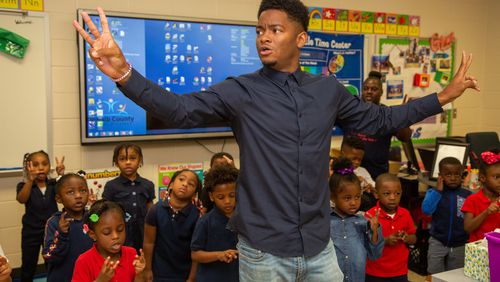Born in 1846 in Philadelphia, education activist Caroline LeCount was the first Black woman to pass the city’s teacher’s examination. As principal of a public school, LeCount championed fellow Black educators. When a new principal was needed at the Wilmot Colored School, LeCount recommended one of her teachers, telling the school board that the candidate was “fully qualified” and “colored children should be taught by their own.”
More than a century and a half later, Black education reformers are still urging school boards to invest in principals and teachers of color. According to the National Center for Education Statistics, 15% of K-12 public school students in the United States are Black. Only 7% of teachers are Black.
Many states and districts have increased efforts to recruit teachers of color. An updated report on the nation’s changing teacher ranks shows those efforts worked. According to the “Transformation of the Teaching Force,” public and private schools employed about 327,000 minority teachers in 1987-88. Thirty years later, there were more than 810,000 minority teachers.
But the study found a hitch: “However, while minorities have entered teaching at higher rates than whites in recent decades, the data also show that the rates at which minority teachers depart from schools is significantly higher than that of white teachers and has also been increasing. In the decades from the late 1980s to 2012-13, the annual rate of minority teacher turnover from public schools increased by 45%, undermining minority teacher recruitment efforts.”
A panel Wednesday on teacher diversity sponsored by Reinventing America’s Schools Project and The 74 looked at how to recruit and retain Black teachers, especially Black males, and why it’s important. An interesting prelude to the panel — a quick electronic polling of the audience watching the webinar — showed that nine out of 10 either had no Black or Latino male teachers in their K-12 classrooms or had three or less.
“Nobody benefits from a very narrow perspective on what the world looks like, and I believe that’s just as true about being exposed to diversity of other children in your class, as well as who you see as role models in your life,” said panelist Kate Walsh, president of the National Council on Teacher Quality.
Research increasingly shows improved outcomes when students see teachers who look like them, said Walsh, explaining, “We now see remarkable outcomes from children being exposed not even just to a teacher in their classroom, but to a teacher in their school who looks like them. We see increased graduation rates. We see much lower referrals to discipline. That is true for white kids with Black teachers, too. Black teachers are much less apt to refer them to discipline.”
Several panelists said too many Black students don’t feel at ease or at home in schools where research suggests they experience higher rates of discipline, suspensions and expulsions. As a result, students develop a negative relationship with school.
“We need to establish and affirm a safe culture for Black and indigenous boys of color in our schools. From the get-go, we are robbing our young men of the opportunity to become educators because we exit them from the education system very early on,” said Daniel Helena, a teacher with Alliance College-Ready Public Schools in Los Angeles. “It is not too far-fetched to say that many boys and, honestly, Black girls, too, learn that this place is not for them, education is not a place for them. Why come back to a place that was traumatic and harmful for you?”
In explaining his 28-year detour from law school to teaching, Sharif El-Mekki said positive experiences as a child in an Afro-centric freedom school led him to a career as a teacher and principal and now CEO of the Center for Black Educator Development.
“I do believe that what my teachers represented, how they were committed to students, to the community, that sense of activism was honed and definitely nurtured in my elementary school experience, which was a full-time freedom school, all Black teachers,” he said. The lesson El-Mekki learned from mentors over the years was that educators were activists, that, as he said, “Teaching Black children well is purest form of activism.”
A DeKalb County native, Helena also found himself taking a detour after graduating from the University of North Carolina Chapel Hill with a degree in journalism. He returned to metro Atlanta, where he joined Teach for America and taught high school in Clayton County.
“There are a lot of obstacles we needlessly put in front of student of colors,” said Helena. “For me, seeing leaders who were Black, indigenous, of color made a big difference. I was more easily able to connect with them. Plus, research shows that Black male teachers are more likely to teach at schools with Black principals. We need to think about how we are mentoring and developing our teachers of color so they can continue to develop others as well.”
Brienne Bellavita, senior advocacy manager for the Walton Family Foundation, said states and districts need to invest in recruitment strategies and alternative pathways that broaden the teacher pipeline, such as grow-your-own-teacher programs, particularly in diverse communities.
Once aspiring teachers make it through programs and into classrooms, Bellavita said there has to be strong induction and mentorship, citing the multiyear support provided to new teachers in Delaware and Iowa as models.
Panelists also blamed the cost of a college degree, coupled with the low starting salaries that climb little over the years, for dissuading college students of color from education careers.
“If you are a talented college student of color these days, you have so many options put before you,” said Walsh. “If you know that you can go out and earn twice as much just getting out of college doing another profession, it takes almost missionary zeal to turn that down. I think we have to acknowledge that teacher pay is a mitigating factor and one that suppresses diversity.”
About the Author







